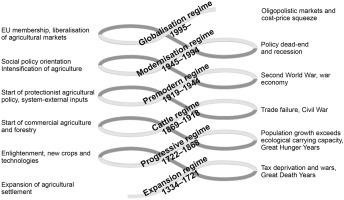Agricultural Systems ( IF 6.6 ) Pub Date : 2023-01-25 , DOI: 10.1016/j.agsy.2023.103604 Irene Kuhmonen , Tuomas Kuhmonen

|
CONTEXT
The escalating sustainability problems of the current agrifood regime call for a radical, systemic transformation. Such a transformation implies a move into a new stability domain, defined by a new set of systemic attractors. These transformations can be conceptualised as regime shifts.
OBJECTIVE
In this study, we explored the history of the Finnish agrifood system in order to learn from the past transformations of the system and to inform the current attempts to steer its development in a more sustainable direction.
METHODS
We conducted a qualitative analysis on literature discussing the history of the Finnish agrifood system by utilising the concept of the adaptive cycle, which captures the cyclicity of the evolution of social-ecological systems.
RESULTS AND CONCLUSIONS
We identified six regimes from the 14th century onwards: Expansion (1334–1721), Progressive (1722–1868), Cattle (1869–1918), Premodern (1919–1944), Modernisation (1945–1994) and Globalisation (1995–). During each regime, the evolution of the system organised around specific attractors which initially opened up new possibilities for the actors, but over time, the very same attractors became the main source of vulnerability in the system. Along with the system's maturation, path-dependency created rigidity, escalating sustainability problems and decreasing room for manoeuvre for the system's actors, concomitantly decreasing the system's resilience. When an external shock related to climatic conditions, economic turbulence or wars coincided with such a rigidity, the system collapsed, the consequences of which span from food shortages to large-scale, deadly famines. The collapse of the old regime opened up the window of opportunity for a regime shift. The most profound regime shifts were related to changes in the system's metabolism and trade orientation.
SIGNIFICANCE
While the conservation phase of the adaptive cycle increases systemic vulnerabilities, it also offers an opportunity for systemic transformation. Allowing the adaptive cycle to play out on smaller scales—such as at the level of farm systems—helps to avoid collapse on the scale of the whole food system. The current agrifood regime in Finland indicates strong path-dependency and rigidity, manifesting a conservation phase, to be followed by release and reorganisation. This observation calls, first, for considering the resilience of the current system to anticipate a crisis and, second, for outlining alternative visions for the sustainable future of the agrifood system.
中文翻译:

通过适应性循环的动态转变:芬兰农产品系统的演变
语境
当前农产品制度不断升级的可持续性问题需要进行彻底的系统性转型。这种转变意味着进入一个新的稳定域,由一组新的系统吸引子定义。这些转变可以概念化为政权更替。
客观的
在这项研究中,我们探索了芬兰农业食品系统的历史,以便从过去的系统转型中吸取教训,并为当前引导其朝着更可持续的方向发展的尝试提供信息。
方法
我们利用适应性循环的概念对讨论芬兰农产品系统历史的文献进行了定性分析,适应性循环捕捉了社会生态系统演变的周期性。
结果和结论
我们确定了 14 世纪以来的六种制度:扩张 (1334–1721)、进步 (1722–1868)、牛 (1869–1918)、前现代 (1919–1944)、现代化 (1945–1994) 和全球化 (1995–) . 在每个政权期间,系统的演变围绕特定的吸引子组织,最初为参与者开辟了新的可能性,但随着时间的推移,同样的吸引子成为系统脆弱性的主要来源。随着系统的成熟,路径依赖造成了僵化,加剧了可持续性问题并减少了系统参与者的回旋余地,同时降低了系统的弹性。当与气候条件、经济动荡或战争相关的外部冲击与这种僵化同时发生时,系统就会崩溃,其后果从粮食短缺到大规模、致命的饥荒。旧政权的垮台为政权更迭打开了机会之窗。最深刻的制度转变与系统新陈代谢和贸易方向的变化有关。
意义
虽然适应性循环的保护阶段增加了系统脆弱性,但它也为系统转型提供了机会。允许适应性循环在较小的规模上发挥作用——例如在农场系统层面——有助于避免整个粮食系统规模崩溃。芬兰目前的农产品制度显示出强烈的路径依赖性和刚性,体现了一个保护阶段,随后是释放和重组。这一观察结果首先要求考虑当前系统预测危机的弹性,其次要求概述农业食品系统可持续未来的替代愿景。


























 京公网安备 11010802027423号
京公网安备 11010802027423号